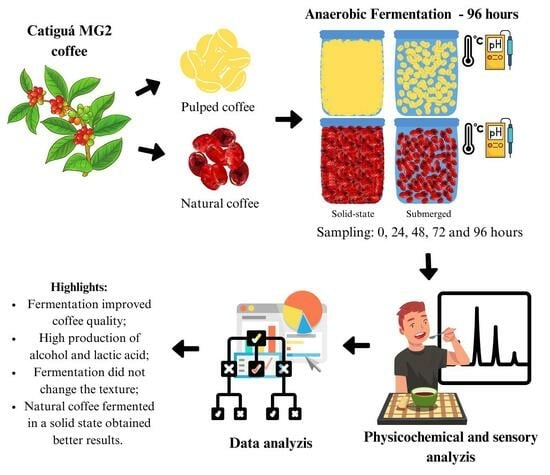Enhancing Sensory Quality of Coffee: The Impact of Fermentation Techniques on Coffea arabica cv. Catiguá MG2
Abstract
1. Introduction
2. Materials and Methods
2.1. Experimental Design and Fermentation
2.2. Physical–Chemical Characterization
2.3. Sensory Analysis
2.4. Data Analysis
3. Results and Discussion
3.1. Dynamics of Temperature and pH during Fermentation
3.2. Green Fruit Percentage and Texture Analysis
3.3. Sugar Consumption and Production of Acids and Alcohols
3.4. Sensorial Analysis
4. Conclusions
Supplementary Materials
Author Contributions
Funding
Institutional Review Board Statement
Informed Consent Statement
Data Availability Statement
Acknowledgments
Conflicts of Interest
References
- Yeoh, L.; Ng, K.S. Future prospects of spent coffee ground valorisation using a biorefinery approach. Resour. Conserv. Recycl. 2022, 179, 106123. [Google Scholar] [CrossRef]
- International Coffee Organization (ICO). Available online: https://www.icocoffee.org/documents/cy2022-23/cmr-0223-e.pdf (accessed on 24 May 2023).
- Conab-Companhia Nacional de Abastecimento. Acompanhamento da Safra Brasileira de Café, Brasília, DF, v. 10, n. 2 Segundo Levantamento, Maio. 2023. Available online: https://www.conab.gov.br/info-agro/safras/cafe/boletim-da-safra-de-cafe (accessed on 14 June 2023).
- Sepúlveda, W.S.; Chekmam, L.; Maza, M.T.; Mancilla, N.O. Consumers’ preference for the origin and quality attributes associated with production of specialty coffees: Results from a cross-cultural study. Food Res. Int. 2016, 89, 997–1003. [Google Scholar] [CrossRef]
- de Lima, L.M.; de Pellegrini Elias, L.; e Silva, M.M.C.D.; da Silva, K.V.; Pacheco, A.S.V. Behavioral aspects of the coffee consumer in different countries: The case of Brazil. In Coffee Consumption and Industry Strategies in Brazil 2020; Woodhead Publishing: Cambridge, UK, 2020; pp. 321–341. [Google Scholar] [CrossRef]
- Júnior, A.I.M.; de Carvalho Neto, D.P.; de Melo Pereira, G.V.; da Silva Vale, A.; Medina, J.D.C.; de Carvalho, J.C.; Soccol, C.R. A critical techno-economic analysis of coffee processing utilizing a modern fermentation system: Implications for specialty coffee production. Food Bioprod. Process. 2021, 125, 14–21. [Google Scholar] [CrossRef]
- Galarza, G.; Figueroa, J.G. Volatile compound characterization of coffee (Coffea arabica) processed at different fermentation times using SPME–GC–MS. Molecules 2022, 27, 2004. [Google Scholar] [CrossRef] [PubMed]
- Specialty Coffee Association. SCA Protocols Cupping Specialty Coffee. 2015. Available online: http://scaa.org/PDF/resources/cupping-protocols.pdf (accessed on 28 May 2023).
- Lingle, T.R. The Coffee Cupper’s Handbook: A Systematic Guide to the Sensory Evaluation of Coffee’s Flavor; Specialty Coffee Association of America: Long Beach, CA, USA, 2011; p. 66. [Google Scholar]
- Cardoso, W.S.; Agnoletti, B.Z.; de Freitas, R.; de Abreu Pinheiro, F.; Pereira, L.L. Biochemical aspects of coffee fermentation. In Quality Determinants in Coffee Production; Springer: Berlin/Heidelberg, Germany, 2021; pp. 149–208. [Google Scholar] [CrossRef]
- Giomo, G.S.; Borém, F.M. Cafés especiais no Brasil: Opção pela qualidade. Inf. Agropecuário Belo Horiz. 2011, 32, 7–16. [Google Scholar]
- Bressani, A.P.P.; Martinez, S.J.; Sarmento, A.B.I.; Borém, F.M.; Schwan, R.F. Influence of yeast inoculation on the quality of fermented coffee (Coffea arabica var. Mundo Novo) processed by natural and pulped natural processes. Int. J. Food Microbiol. 2021, 343, 109107. [Google Scholar] [CrossRef] [PubMed]
- da Mota, M.C.B.; Batista, N.N.; Dias, D.R.; Schwan, R.F. Impact of microbial self-induced anaerobiosis fermentation (SIAF) on coffee quality. Food Biosci. 2022, 47, 101640. [Google Scholar] [CrossRef]
- de Jesus Cassimiro, D.M.; Batista, N.N.; Fonseca, H.C.; Naves, J.A.O.; Dias, D.R.; Schwan, R.F. Coinoculation of lactic acid bacteria and yeasts increases the quality of wet fermented Arabica coffee. Int. J. Food Microbiol. 2022, 369, 109627. [Google Scholar] [CrossRef]
- Rodrigues, S.D.; Coelho, V.S.; Freitas, V.V.; Brioschi, A.; Brioschi Júnior, D.; Guarçoni, R.C.; Cardoso, W.S.; Pereira, L.L.; Eller, M.R. Sensory Q-Grader evaluation of fermented arabica coffees by yeast (Saccharomyces cerevisiae) and lactic bacteria (Pediococcus acidilactici) cultures. Contin. Publ. 2020, 15, e151690. [Google Scholar] [CrossRef]
- Martinez, S.J.; Rabelo, M.H.S.; Bressani, A.P.P.; Da Mota, M.C.B.; Borém, F.M.; Schwan, R.F. Novel stainless steel tanks enhances coffee fermentation quality. Food Res. Int. 2021, 139, 109921. [Google Scholar] [CrossRef]
- Elhalis, H.; Cox, J.; Frank, D.; Zhao, J. The role of wet fermentation in enhancing coffee flavor, aroma and sensory quality. Eur. Food Res. Technol. 2021, 247, 485–498. [Google Scholar] [CrossRef]
- Chalfoun, S.M.; Fernandes, A.P. Efeitos da fermentação na qualidade da bebida do café. Visão Agrícola USP 2013, 1, 105–108. [Google Scholar]
- Filete, C.A.; de Sousa, L.H.B.P.; Guarçoni, R.C.; Junior, D.B.; Marcate, J.P.P.; Moreli, A.P.; Moreira, T.R.; Gomes, W.D.S.; de Andrade Siqueira, E.; Pereira, L.L. Fermentação Anaeróbica no café arábica e seu impacto no perfil sensorial. Rev. Eletrônica Sala De Aula Em Foco 2020, 6, 112–123. [Google Scholar] [CrossRef]
- Pereira, L.L.; Moreira, T.R. Quality Determinants in Coffee Production; Springer International Publishing: Berlin/Heidelberg, Germany, 2021; pp. 303–308. [Google Scholar]
- Ferreira, L.J.C.; de Souza Gomes, M.; de Oliveira, L.M.; Santos, L.D. Coffee fermentation process: A review. Food Res. Int. 2023, 169, 112793. [Google Scholar] [CrossRef]
- Pereira, A.A.; Alvarenga, A.P.; Sakiyama, N.S.; Carvalho, G.R.; Oliveira, A.C.B.; Ribeiro, M.F.; Zambolim, L. Cup quality of new cultivars derived from Híbrido de Timor. In Proceedings of the 22nd International Conference on Coffee Science, ASIC 2008, Campinas, SP, Brazil, 14–19 September 2008; pp. 398–399. [Google Scholar]
- Pereira, A.A.; Oliveira, A.C.B.; Botelho, C.E.; Carvalho, G.R.; Rezende, J.C. Cultivares de café arábica desenvolvidas pela EPAMIG e instituições parceiras. Inf. Agropecuário. Belo Horiz. 2013, 34, 44–53. [Google Scholar]
- Mesquita, C.D.; Rezende, J.E.; Carvalho, J.S.; Júnior, M.A.D.; MORAES, N.C.; Tavares, P.; Carvalho, A.M.; Araújo, W.G. Manual do café: Colheita e preparo (Coffea arábica L.). Belo Horiz. EMATER-MG 2016, 1, 1–56. [Google Scholar]
- Nascimento, A.C.D.; Cunha Junior, A.P.D.; Silva, C.R.G.; Leão, M.V.P.; Santos, S.S.F.D. Estabilidade do ácido peracético no processo de desinfecção prévia à lavagem. Rev. Da Assoc. Paul. De Cir. Dent. 2015, 69, 367–382. [Google Scholar]
- Association of Official Analytical Chemists; Association of Official Agricultural Chemists (US). Official Methods of Analysis of the Association of Official Analytical Chemists; Association of Official Analytical Chemists: Rockville, MD, USA, 1990; Volume 15. [Google Scholar]
- Elhalis, H.; Cox, J.; Zhao, J. Ecological diversity, evolution and metabolism of microbial communities in the wet fermentation of Australian coffee beans. Int. J. Food Microbiol. 2020, 321, 108544. [Google Scholar] [CrossRef]
- Hammer, Ø.; Harper, D.A. Past: Paleontological statistics software package for educaton and data anlysis. Palaeontol. Electron. 2001, 4, 1. [Google Scholar]
- Avallone, S.; Guyot, B.; Brillouet, J.M.; Olguin, E.; Guiraud, J.P. Microbiological and biochemical study of coffee fermentation. Curr. Microbiol. 2001, 42, 252–256. [Google Scholar] [CrossRef]
- Martins, P.M.M.; Batista, N.N.; Miguel, M.G.D.C.P.; Simão, J.B.P.; Soares, J.R.; Schwan, R.F. Coffee growing altitude influences the microbiota, chemical compounds and the quality of fermented coffees. Food Res. Int. 2020, 129, 108872. [Google Scholar] [CrossRef] [PubMed]
- Córdoba-Castro, N.A.N.C.Y.; GUERRERO-FAJARDO, J.E. Caracterización de los procesos tradicionales de fermentación de café en el departamento de Nariño. Biotecnol. En El Sect. Agropecu. Y Agroindustrial 2016, 14, 75–83. [Google Scholar] [CrossRef]
- Peñuela-Martínez, A. Estudio de la Remoción del Mucílago de Café a Través de Fermentación Natural [Tesis Maestría en Desarrollo Sostenible y Medio Ambiente]; Universidad de Manizales, Facultad de Ingeniería: Manizales, Colombia, 2010. [Google Scholar]
- Ziaiifar, A.M.; Nedamani, A.R.; Aghajanzadeh, S. Conductive Heat Transfer in Food Processing. In Engineering Principles of Unit Operations in Food Processing; Woodhead Publishing: Cambridge, UK, 2021; pp. 281–313. [Google Scholar] [CrossRef]
- Evangelista, S.R.; Silva, C.F.; da Cruz Miguel, M.G.P.; de Souza Cordeiro, C.; Pinheiro, A.C.M.; Duarte, W.F.; Schwan, R.F. Improvement of coffee beverage quality by using selected yeasts strains during the fermentation in dry process. Food Res. Int. 2014, 61, 183–195. [Google Scholar] [CrossRef]
- Mazzafera, P. Chemical composition of defective coffee beans. Food Chem. 1999, 64, 547–554. [Google Scholar] [CrossRef]
- Velásquez, S.; Peña, N.; Bohórquez, J.C.; Gutierrez, N.; Sacks, G.L. Volatile and sensory characterization of roast coffees–Effects of cherry maturity. Food Chem. 2019, 274, 137–145. [Google Scholar] [CrossRef] [PubMed]
- Aswathi, K.N.; Shirke, A.; Praveen, A.; Chaudhari, S.R.; Murthy, P.S. Pulped natural/honey robusta coffee fermentation metabolites, physico-chemical and sensory profiles. Food Chem. 2023, 429, 136897. [Google Scholar] [CrossRef]
- de Carvalho Neto, D.P.; de Melo Pereira, G.V.; Tanobe, V.O.; Thomaz Soccol, V.G.; da Silva, B.J.; Rodrigues, C.; Soccol, C.R. Yeast diversity and physicochemical characteristics associated with coffee bean fermentation from the Brazilian Cerrado Mineiro region. Fermentation 2017, 3, 11. [Google Scholar] [CrossRef]
- da Silva Vale, A.; Balla, G.; Rodrigues, L.R.S.; de Carvalho Neto, D.P.; Soccol, C.R.; de Melo Pereira, G.V. Understanding the Effects of Self-Induced Anaerobic Fermentation on Coffee Beans Quality: Microbiological, Metabolic, and Sensory Studies. Foods 2022, 12, 37. [Google Scholar] [CrossRef]
- Jimenez, E.J.M.; Martins, P.M.M.; de Oliveira Vilela, A.L.; Batista, N.N.; da Rosa, S.D.V.F.; Dias, D.R.; Schwan, R.F. Influence of anaerobic fermentation and yeast inoculation on the viability, chemical composition, and quality of coffee. Food Biosci. 2023, 51, 102218. [Google Scholar] [CrossRef]
- Madigan, M.T.; Martinko, J.M.; Bender, K.S.; Buckley, D.H.; Stahl, D.A. Microbiologia de Brock-14ª Edição; Artmed Editora: Porto Alegre, Brazil, 2016. [Google Scholar]
- Bastian, F.; Hutabarat, O.S.; Dirpan, A.; Nainu, F.; Harapan, H.; Emran, T.B.; Simal-Gandara, J. From plantation to cup: Changes in bioactive compounds during coffee processing. Foods 2021, 10, 2827. [Google Scholar] [CrossRef]
- Buffo, R.A.; Cardelli-Freire, C. Coffee flavour: An overview. Flavour Fragr. J. 2004, 19, 99–104. [Google Scholar] [CrossRef]
- Zhao, N.; Kokawa, M.; Amini, R.K.; Dong, W.; Kitamura, Y. Isolation of Yeast and LAB from Dry Coffee Pulp and Monitoring of Organic Acids in Inoculated Green Beans. Foods 2023, 12, 2622. [Google Scholar] [CrossRef] [PubMed]
- Smarrito-Menozzi, C.; Matthey-Doret, W.; Devaud-Goumoens, S.; Viton, F. Glycerol, an underestimated flavor precursor in the Maillard reaction. J. Agric. Food Chem. 2013, 61, 10225–10230. [Google Scholar] [CrossRef] [PubMed]
- de Melo Pereira, G.V.; de Carvalho Neto, D.P.; Júnior, A.I.M.; Vásquez, Z.S.; Medeiros, A.B.; Vandenberghe, L.P.; Soccol, C.R. Exploring the impacts of postharvest processing on the aroma formation of coffee beans–A review. Food Chem. 2019, 272, 441–452. [Google Scholar] [CrossRef] [PubMed]
- Pereira, L.L.; Júnior, D.B.; de Sousa, L.H.B.P.; dos Santos Gomes, W.; Cardoso, W.S.; Guarçoni, R.C.; ten Caten, C.S. Relationship between Coffee Processing and Fermentation. Qual. Determ. Coffee Prod. 2021, 1, 255–301. [Google Scholar] [CrossRef]

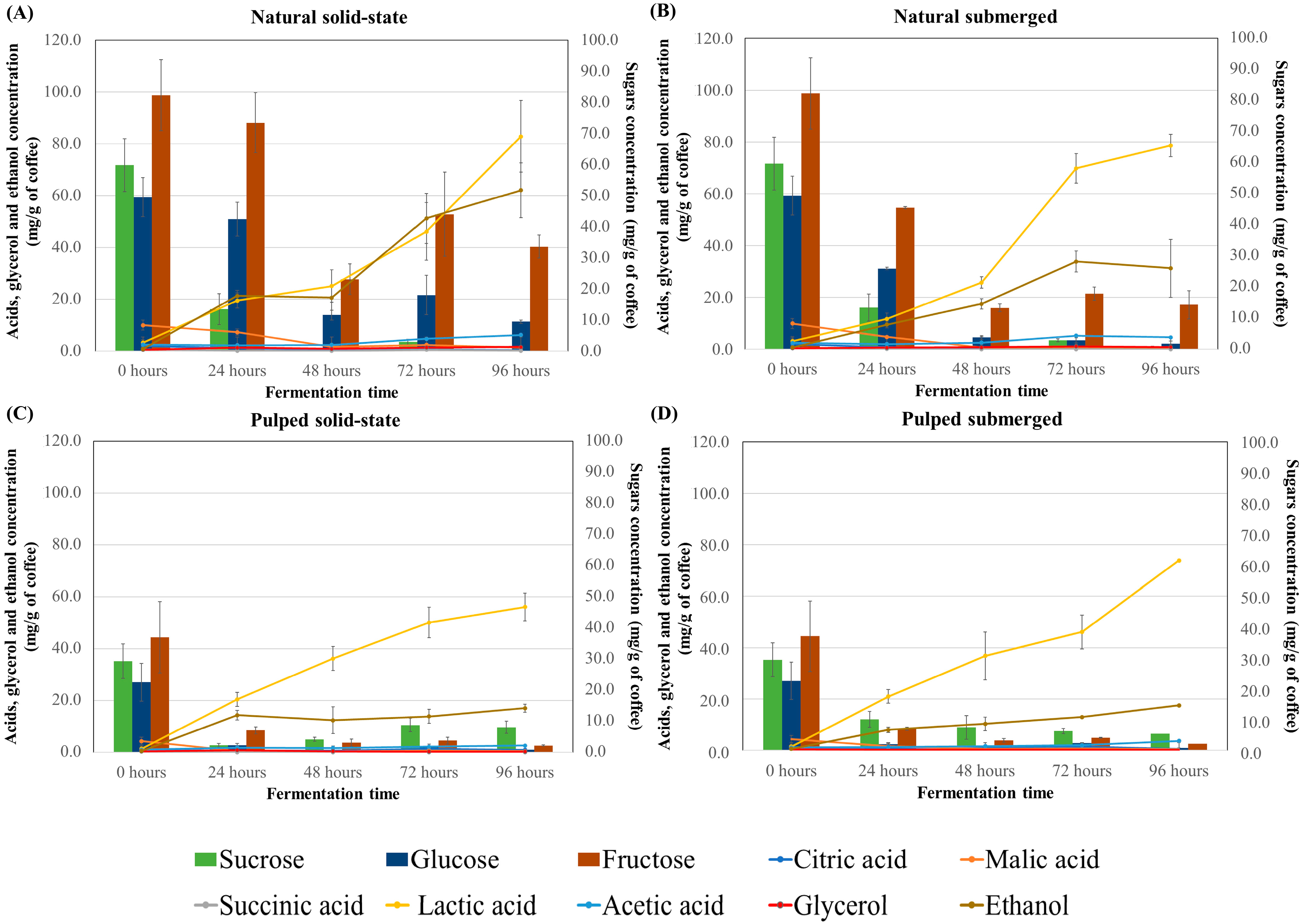
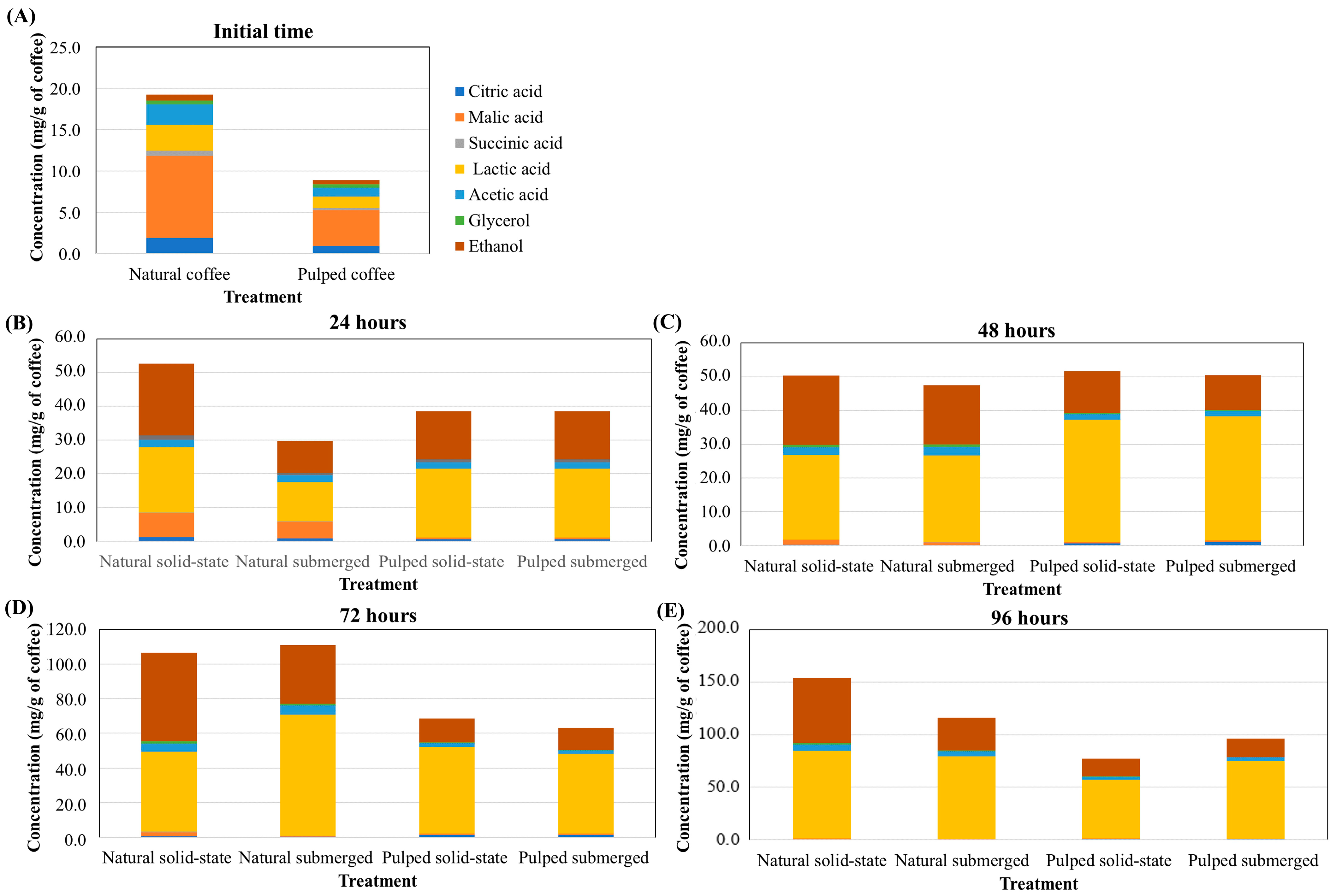
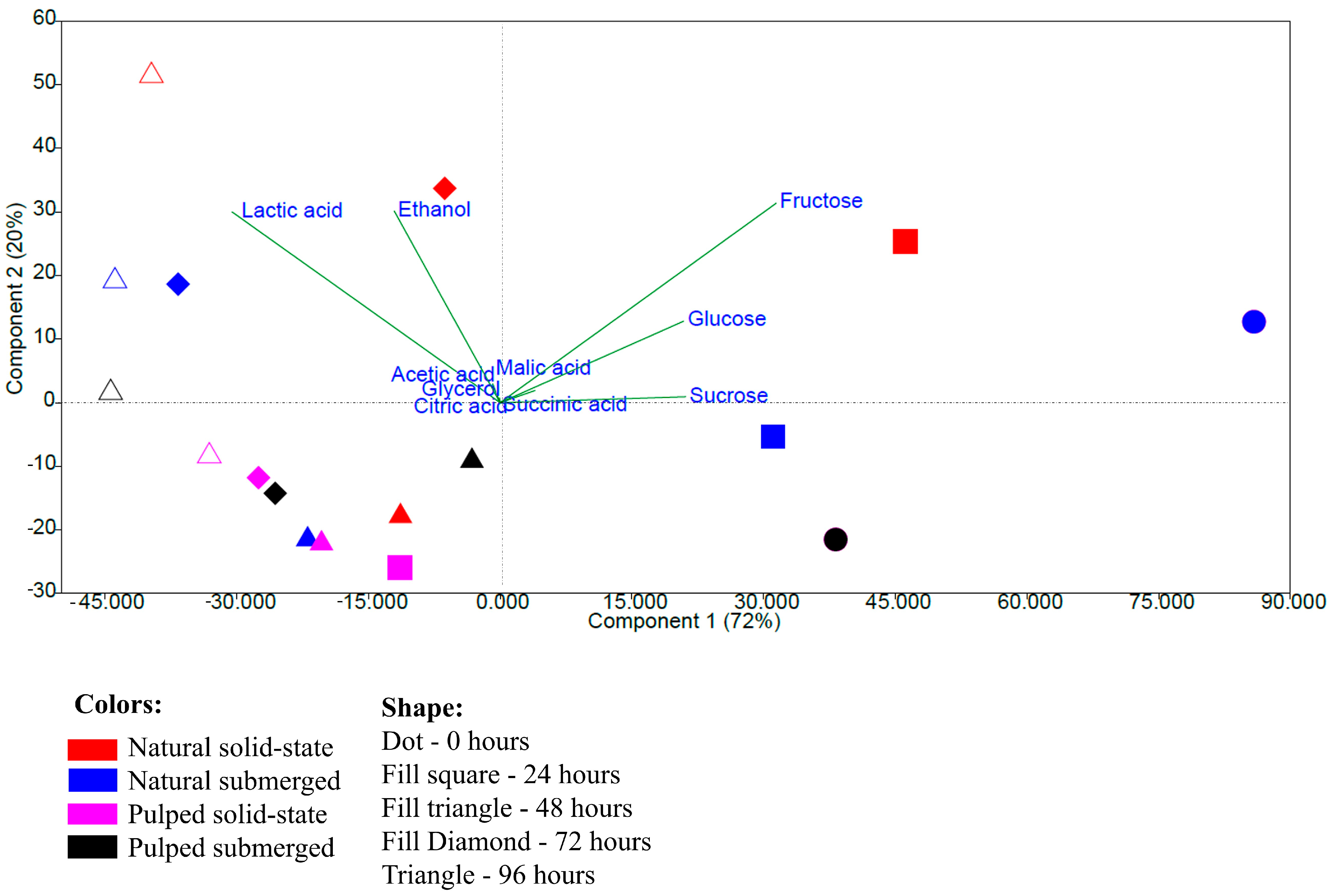
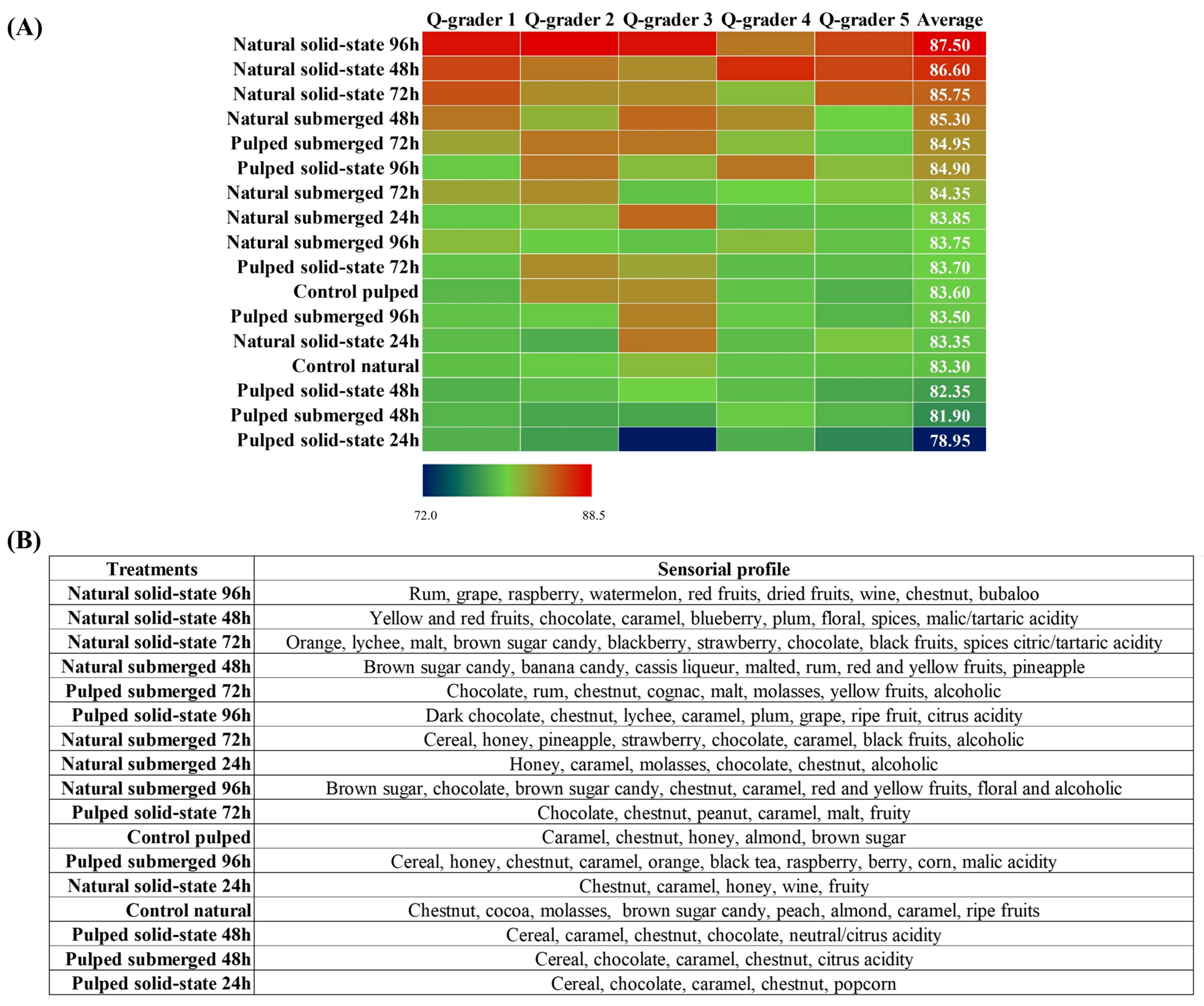
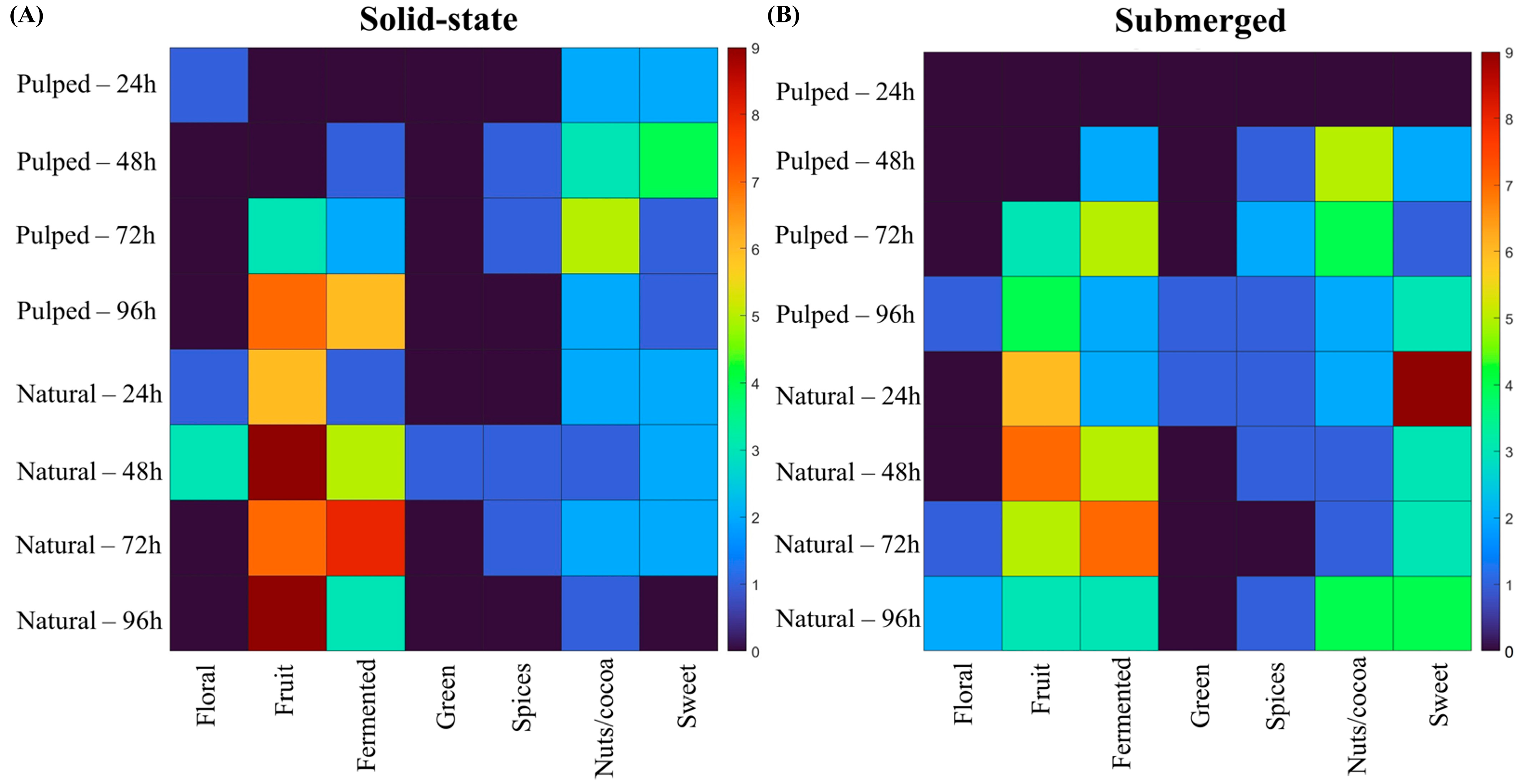
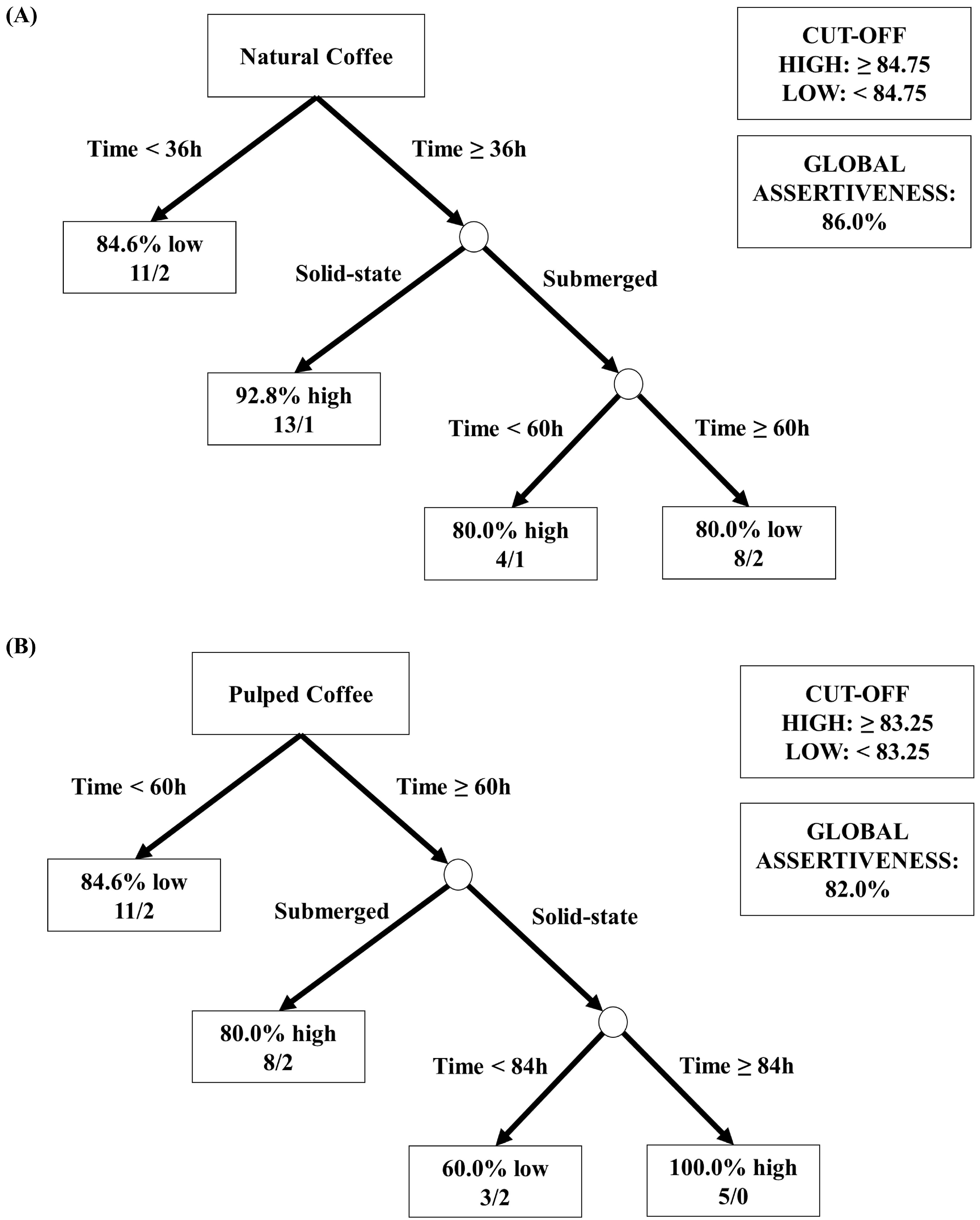
Disclaimer/Publisher’s Note: The statements, opinions and data contained in all publications are solely those of the individual author(s) and contributor(s) and not of MDPI and/or the editor(s). MDPI and/or the editor(s) disclaim responsibility for any injury to people or property resulting from any ideas, methods, instructions or products referred to in the content. |
© 2024 by the authors. Licensee MDPI, Basel, Switzerland. This article is an open access article distributed under the terms and conditions of the Creative Commons Attribution (CC BY) license (https://creativecommons.org/licenses/by/4.0/).
Share and Cite
Silva, L.C.F.; Pereira, P.V.R.; Cruz, M.A.D.d.; Costa, G.X.R.; Rocha, R.A.R.; Bertarini, P.L.L.; Amaral, L.R.d.; Gomes, M.S.; Santos, L.D. Enhancing Sensory Quality of Coffee: The Impact of Fermentation Techniques on Coffea arabica cv. Catiguá MG2. Foods 2024, 13, 653. https://doi.org/10.3390/foods13050653
Silva LCF, Pereira PVR, Cruz MADd, Costa GXR, Rocha RAR, Bertarini PLL, Amaral LRd, Gomes MS, Santos LD. Enhancing Sensory Quality of Coffee: The Impact of Fermentation Techniques on Coffea arabica cv. Catiguá MG2. Foods. 2024; 13(5):653. https://doi.org/10.3390/foods13050653
Chicago/Turabian StyleSilva, Lívia C. F., Paulo V. R. Pereira, Marcelo A. D. da Cruz, Gisele X. R. Costa, Renata A. R. Rocha, Pedro L. L. Bertarini, Laurence R. do Amaral, Matheus S. Gomes, and Líbia D. Santos. 2024. "Enhancing Sensory Quality of Coffee: The Impact of Fermentation Techniques on Coffea arabica cv. Catiguá MG2" Foods 13, no. 5: 653. https://doi.org/10.3390/foods13050653
APA StyleSilva, L. C. F., Pereira, P. V. R., Cruz, M. A. D. d., Costa, G. X. R., Rocha, R. A. R., Bertarini, P. L. L., Amaral, L. R. d., Gomes, M. S., & Santos, L. D. (2024). Enhancing Sensory Quality of Coffee: The Impact of Fermentation Techniques on Coffea arabica cv. Catiguá MG2. Foods, 13(5), 653. https://doi.org/10.3390/foods13050653






